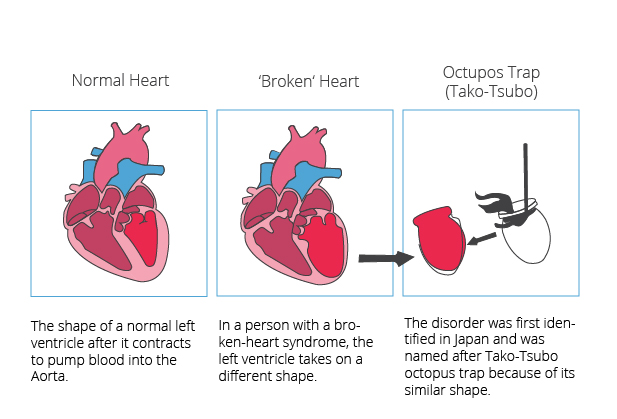Broken Heart Syndrome – Stress Cardiomyopathy – Takotsubo Cardiomyopathy
Stress Cardiomyopathy (Takotsubo Cardiomyopathy) is a non-ischemic dysfunction of the heart muscle, commonly known as “broken heart syndrome.” Although the name may not sound like it, it is a serious disease typically caused by severe stress. This clinical syndrome occurs frequently in post-menopausal women in connection with strong emotional stressors. In a large number of cases, a false diagnosis is made (i.e. a Heart Attack), meaning Broken Heart Syndrome goes unrecognized.
What are some symptoms of Broken Heart Syndrome?
What causes Broken Heart Syndrome?
How is Broken Heart Syndrome diagnosed?
What updates have come from new research on Broken Heart Syndrome?
What are some symptoms of Broken Heart Syndrome?
The symptoms associated with Broken Heart Syndrome are often nearly identical to those of a Heart Attack, and occur following periods of intense emotional or physical stress. Those affected may experience pain or tightness of the chest, a racing heart or difficulty breathing. In this disease, the shape of the left ventricle changes, with the left ventricular apex expanding into a balloon-like form. This new shape is said to resemble a Japanese Octopus fishing pot called Takotsubo, for which it received the name in the 1990’s when it was first discovered.

What causes Broken Heart Syndrome?
The exact cause of Broken Heart Syndrome is not fully understood. Possible causes include a persistently elevated stress level or a tumor (catecholamine-producing tumor). A catecholamine-producing tumor causes increased hormone (catecholamine) release, which may contribute to the dysfunction of heart muscle cells. Additional potential causes include: hormonal changes (sympathetic system activation via estrogen deficit), viruses (i.e. Cytomegalovirus) or a genetic predisposition. A clearly elevated level of catecholamines or adrenaline is found particularly often in female patients. The stress hormones are typically released following physically or emotionally stressful situations such as a death, panic attack, separation from a partner, domestic violence or severe anxiety. Those affected by takotsubo cardiomyopathy have a more sensitive physical and/or emotional response to the stressor than those not affected. Additional possible physical stressors include lung disease, bleeding in the brain, stroke, a head injury, surgical intervention or severe pain. The common saying “something is breaking my heart” therefore appears to be medically supported.
How is Broken Heart Syndrome diagnosed?
Findings associated with Takotsubo Cardiomyopathy include: sudden left ventricular dysfunction (failure), elevated blood levels of the cardiac enzyme Troponin-T, normal coronary angiography results (i.e. no blockage of the coronary arteries) and specific ECG changes (ST-segment elevation, QT prolongation, T wave changes) suggestive of Takotsubo Cardiomyopathy. In comparison to a Heart Attack, there is no blockage of a coronary vessel; this can be ruled out with a cardiac catheterization. The workup also often includes examination of additional cardiac enzymes, bodily fluids, organs (i.e. the Thyroid), a chest x-ray, and an ultrasound of the abdomen and heart. On top of all of this, a thorough medical history is crucial in order to determine the possible initiating stressful event. The heart function improves on its own in 99% of cases, with approximately 1% of patients dying from complications such as rhythm disorders. It is therefore important that those affected are monitored closely in the hospital during the acute phase until the heart function has fully recovered.
What updates have come from new research on Broken Heart Syndrome?
According to Dr. Christian Möller (Universitätsklinikum Schleswig Holstein, Lübeck), cancer patients have an elevated risk for Broken Heart Syndrome, aka stress cardiomyopathy. A stress cardiomyopathy should therefore be seen as an indicator of a possible currently unfound cancer diagnosis. These new results were presented at the 82nd annual conference of the German Society of Cardiology (DGK) in Mannheim in 2016. The goal of the study was to examine the frequency of cancer in 286 patients with stress cardiomyopathy. The observation period lasted, on average, four years. Within the study, 18% of those with stress cardiomyopathy were found to have cancer as well. Based on these results, Dr. Möller recommends a work-up to look for a tumor (including an xray of the chest, ultrasound of the abdomen, blood work and a general cancer screening) in those with takotsubo cardiomyopathy.
(Source: DGK Abstract V 500, Möller et al. Prevalence and Long-term Prognostic Impact of Malignancies in Patients with Takotsubo Cardiomyopathy – Insights from a Large Registry. Clin Res Cardiol 105, Suppl 1, March 2016).
1 DGK Abstract V 500, Möller et al. Prevalence and Long-term Prognostic Impact of Malignancies in Patients with Takotsubo Cardiomyopathy – Insights from a Large Registry. Clin Res Cardiol 105, Suppl 1, March 2016